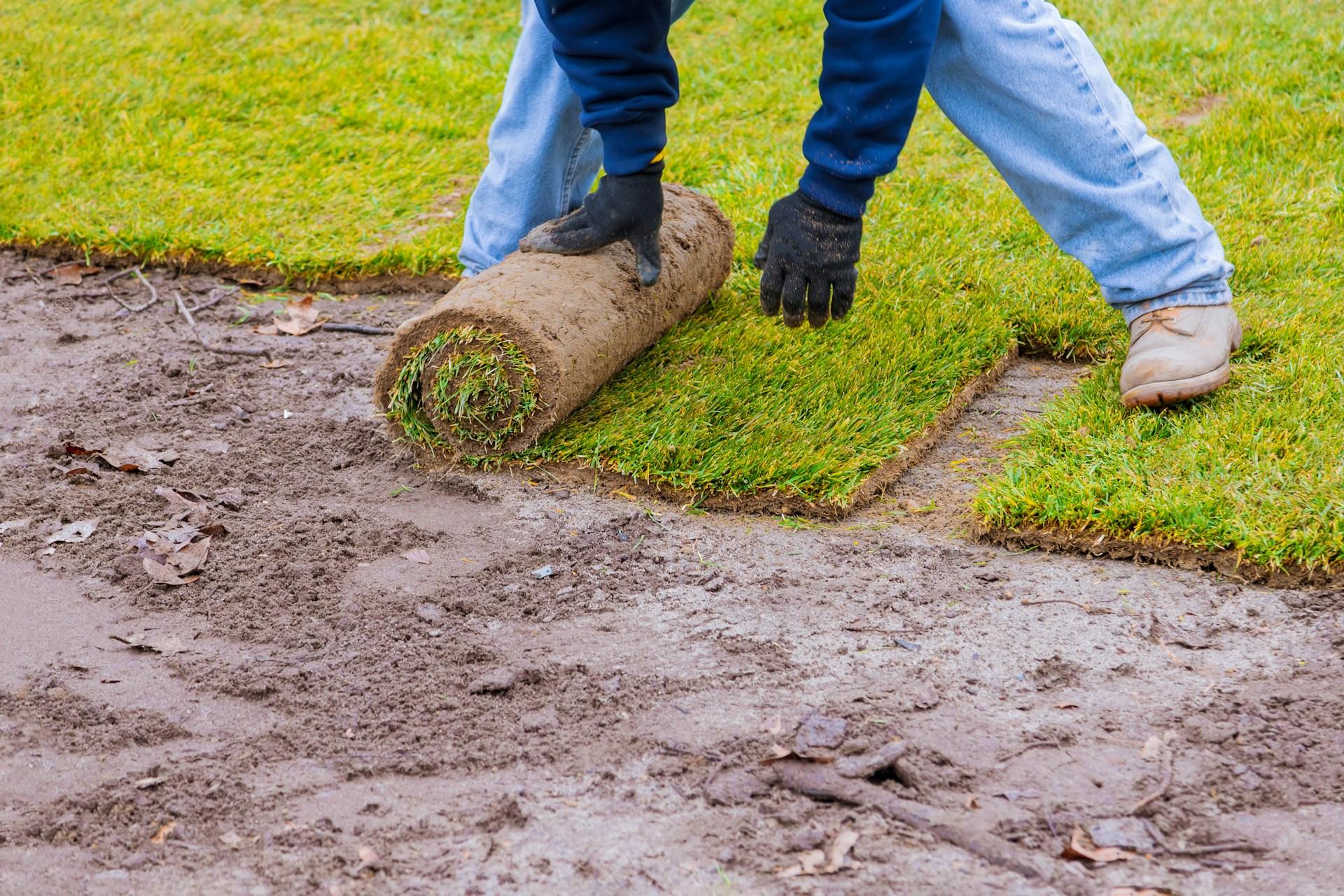Sodding is a quick way to get a lush, green lawn. It involves laying down rolls or squares of pre-grown grass, which is particularly useful around trees and other landscape features where growing grass from seed might be difficult. This article explains why sodding is beneficial in these areas, what you need to prepare, how to install the sod, and tips for keeping it healthy.
Benefits of Sodding Around Trees and Landscaping Features
Instant Lawn
Sodding is like laying down an instant carpet of green. When you lay sod, you immediately replace a bare or uneven patch of land with lush, mature grass. This is especially advantageous around trees and landscape features where bare soil can detract from the beauty of the setting. By using sod, you can enhance the visual appeal of these areas quickly, making them blend seamlessly with the rest of your garden. It’s perfect for hosting events or simply enjoying an upgraded garden view without waiting for seeds to grow.
Prevents Erosion
Erosion control is a significant benefit of sodding, particularly in areas with slopes or hills near trees and other landscaping features. When sod is laid, its roots quickly begin to knit with the soil beneath, forming a solid mass that is less susceptible to erosion. This is crucial for protecting the soil around landscaping features from being washed away during heavy rains. The root system of the sod holds the soil in place, ensuring that nutrients aren’t lost to runoff and that nearby plants and trees have stable ground to thrive in.
Blocks Weeds
Sod comes fully grown and densely packed, which is a natural barrier against weeds. Weeds need light and space to grow, and sod’s thickness blocks the sun from reaching the soil where weed seeds typically germinate. This helps maintain a clean and attractive garden around your landscaping features, reducing the need for frequent weeding and the use of chemical herbicides. This not only saves time and effort in garden maintenance but also helps in keeping your garden healthier and more natural.
Ready for Use
One of the practical benefits of sod is its ability to tolerate foot traffic much sooner than seeded lawns. This makes it an excellent choice for areas around pathways, patios, or garden benches where people frequently walk or gather. Within a few weeks, the sod is usually established enough to handle regular use, which means you don’t have to keep these areas off-limits for long. Whether it’s a path leading to a gazebo or a grassy area near a playground, sod allows these spaces to be functional shortly after installation, enhancing the usability of your outdoor areas right away.
Considerations for Preparation
Check the Soil
The soil surrounding trees and landscaping features frequently suffers from compaction or lacks essential nutrients, making it a less than ideal foundation for sod. Before laying sod, it’s critical to assess the soil’s condition. Start by testing the soil’s pH and nutrient levels—this can guide you on what amendments are needed. For soils that are too acidic or alkaline, liming materials or sulfur can be added to adjust the pH to a level suitable for grass.
If the soil is nutrient-poor, enriching it with organic matter such as compost or well-rotted manure can boost its fertility and improve its structure, which enhances root growth and water retention. Tilling the soil gently to incorporate these amendments can help, but be careful not to disturb any existing landscape elements or go too deep where tree roots may be present.
Protect Tree Roots
The roots of a tree are vital to its health, providing it with water and nutrients. When preparing to lay sod, it’s important to minimize any disturbance to these roots. Avoid deep tilling or digging around trees, as this can sever roots and stress the tree. Instead, start your soil preparations a few inches away from the trunk—generally, no closer than the drip line, which is the outermost circumference of the tree’s branches.
If you must work near roots, do so cautiously. Use a hand trowel for any close work and gently loosen the soil without cutting into roots. This approach protects the tree while also providing a good base for the sod. Remember, the health of the tree can directly impact the health of your new sod, as a stressed tree may compete more aggressively for water and nutrients.
Consider the Shade
Different types of sod have varying requirements for sunlight. When choosing sod to lay around trees and in landscaped areas, consider how much shade these areas receive throughout the day. Grass types like Tall Fescue and Fine Fescue are well-suited for shaded areas and can thrive with minimal direct sunlight. In contrast, grasses like Bermuda and Zoysia prefer full sun and might not do as well in shaded conditions.
Evaluate the pattern of sunlight throughout the day and seasonally, as the angle of the sun changes. This will help you determine which type of sod is most likely to succeed in each part of your yard. In heavily shaded areas, it might also be beneficial to trim tree branches to increase sunlight exposure, but this should be done carefully to maintain the health and natural shape of the trees.
Selecting the right sod for the available light conditions and preparing the soil with consideration to the surrounding landscape and tree health are crucial steps. This preparation ensures that the sod not only takes root but thrives, integrating seamlessly into your garden and creating a lush, green environment.
Properly installing sod is crucial for its success, especially around trees and landscaping features. Here’s how to ensure your sod installation promotes healthy growth and integrates beautifully with your existing garden:
Fit to Shape
To make sure your sod fits perfectly around trees and landscape features, precise cutting is key. Start by measuring the area where the sod will be placed. Use a sharp knife or a half-moon edger for cutting the sod to the exact size and shape required. It’s important to cut the sod while it’s moist to make the process easier and to prevent the edges from fraying.
When laying sod around curved or irregularly shaped areas, such as tree roots or garden paths, additional care is needed. Cut the sod so that it contours closely to the natural shapes of these features. This ensures tight seams between sod pieces and better contact with the underlying soil, which is crucial for root establishment. The goal is to avoid large gaps or overlaps that could lead to drying edges and poor rooting.
Stagger the Seams
Laying sod with staggered seams is similar to laying bricks in a wall. Each row of sod should be offset from the one before it to prevent the seams from lining up across consecutive rows. This technique not only enhances the lawn’s appearance but also significantly strengthens the sod structure, reducing the risk of erosion and shifting.
Staggering seams helps distribute the points where sod pieces meet, which can be potential weak spots, across a larger area. It prevents water from channeling along straight seams, which could lead to erosion under the sod. This method also helps the sod blend seamlessly into the landscape, reducing visible lines and creating a more natural-looking lawn.
Water Right Away
Immediately after installing the sod, it’s critical to water it thoroughly. This initial watering is essential for settling the sod into place, eliminating air pockets, and ensuring good contact with the soil beneath. Air pockets can prevent roots from establishing by drying out parts of the sod.
For the first watering, apply enough water to penetrate the sod and moisten the underlying soil to a depth of several inches. This helps encourage the roots to grow downward in search of moisture, promoting strong root development. Be vigilant about the watering schedule over the first few weeks, keeping the sod consistently moist but not soggy. In areas where the ground is uneven or sloped, pay special attention to ensure that water is reaching all areas uniformly.
Maintenance Tips
Regular Watering
After laying sod, especially around trees and landscape features, it’s crucial to maintain the right moisture levels. In the initial weeks, the sod should be kept moist but not overly saturated. This balance prevents the roots from rotting or the sod from drying out and dying. The frequency of watering can vary, typically once or twice daily, depending on the climate and weather conditions. For instance, during hotter days, more frequent watering may be necessary to keep the sod hydrated. Conversely, on cooler or cloudy days, you might need to water less often. An effective way to ensure uniform moisture is by using a sprinkler system that can be adjusted according to the weather and the soil’s moisture levels.
Fertilization
Approximately four to six weeks following the sod installation, it’s advisable to apply a starter fertilizer to aid in the establishment of new grass. This type of fertilizer typically has a higher phosphorus content, which is crucial for root development. However, it’s essential to choose a fertilizer that is compatible with the existing plants and trees in your landscape to avoid any potential harm. Products specifically labeled as safe for surrounding flora should be used. Apply the fertilizer according to the manufacturer’s instructions, and ensure even coverage to promote uniform growth. Avoid over-fertilization, which can lead to nutrient runoff and potential damage to both the new sod and existing garden features.
Mowing
Mowing plays a vital role in the establishment and maintenance of new sod. The first mowing should occur once the sod has sufficiently rooted into the soil, a process that typically takes about two to three weeks. To test if the sod has rooted, gently tug on the grass; if it doesn’t come up easily, it’s ready to be mowed. Set the mower to a high setting for the first few cuts to avoid stressing the grass. Gradually lower the blade to the desired height over subsequent mowings. Regular mowing not only helps in thickening the grass but also encourages deeper root growth, which contributes to a more resilient lawn.
Tree Care
Caring for trees near the sodded area is crucial, as changes in soil conditions due to sodding could impact their health. One common issue is the alteration of soil moisture levels—sod may either decrease or trap moisture around the roots, depending on the local conditions. To manage this, mulching around the base of the tree proves beneficial. Mulch helps conserve moisture, suppress weeds, and stabilize soil temperature. However, it’s important to avoid piling mulch directly against the tree trunk, which can lead to moisture buildup and encourage fungal diseases or rot. Instead, maintain a mulch-free space around the trunk and spread the mulch evenly in a donut shape to cover the root area effectively.
Conclusion
In conclusion, sodding around trees and landscaping features can significantly enhance the beauty and functionality of a landscape. By carefully selecting the right type of sod, preparing the soil properly, and following correct installation and maintenance practices, homeowners and landscaping professionals can achieve a lush, healthy lawn that complements the natural environment and protects the long-term health of trees and garden features.






